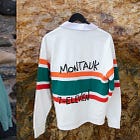📎 How to Use AI in Brand | Part 2: Building Brand Foundations
How to get more than boring dreck out of LLMs!
It’s Friday! We made it! Give yourself a pat on the back, book yourself a massage, order a chocolate milkshake, watch Hocus Pocus for the umpteenth time, take a walk in the glorious September sunshine. While I’m excited about the next part in this series, this is also your sign to touch grass alongside enduring tech’s endless AI chatter… you can be a busy, self-bettering professional AND turn your brain off from all of this now and then. 🍟 Life’s all about balance, isn’t it?
I do want to remind you that today’s the last day to take Typeform’s Get Real survey on the ways you’re seeing gen AI reshaping marketing, and I would genuinely love to hear what On Brand readers are thinking. 👉🏼 If you can, take 10 minutes to share your thoughts. Then keep your eyes peeled for the hot, hot readout later this quarter!
You’re here because you recently subscribed or signed up for one of my resources—my course waitlist on Maven, lightning lesson, or Notion templates.
If someone sent you this post and you’re not subscribed, join those people learning how to tactically advocate for brand at your company. 📬
Last week in 📎 How to Use AI in Brand | Part 1: Using LLMs to Understand Your Audience, we talked about ways to use AI to more deeply understand your audience through data you already have—things like sales transcripts, support tickets, competitive analysis, and social listening. Now comes the harder part: translating those insights into good brand foundations, and by good, I mean they help you create brand-market fit.
This is where teams often get stuck—they have solid audience research, but when it comes to developing positioning and messaging, they default to the same generic language everyone else uses. Or they swing too far in the opposite direction and create messaging so “unique” it confuses their audience (and everyone else internally).
Today, I’m sharing a few of the systematic approaches I’ve found help bridge the gap between LLM-derived research insights and strategic brand direction.
Before we start: What’s the end goal?
Above I mentioned that we’re developing a brand strategy specifically to help us find brand-market fit (BMF). You might recall my two-parter from the other week (part 1, why you need BMF and part 2, how to find BMF). Brand-market fit is the degree to which a company’s identity, values, and overall customer experience resonate with and meet the emotional and aspirational needs of its target market.
Your AI research from Part 1 should have shown you not just your audience’s functional needs, but emotional ones too. Your brand strategy needs to address both, and most of today’s prompts should help with this:
Functional: What job does your product do?
Emotional: How does choosing your brand make them feel or look?
🧷 A disclaimer before we begin: I’m not one of those people who is obsessed with prompting optimization, and I’m still (always) learning. These aren’t intricate or complex prompts, and I guarantee each one I share below can be improved and refined, let alone customized to your use case—so take them as a starting point, see what works for you, and tell me what you learn as you go!
Technique 1: Identify positioning white space
Homework: Take your competitive analysis from Part 1 (this builds on what you already did with Technique #2 from that post) and use an LLM to further map out where you have possible opportunities to differentiate.
The prompt:
Based on this competitive messaging analysis, create a positioning map that shows:
1. What territory each competitor owns (their core message/benefit)
2. Where competitors cluster (oversaturated messaging areas)
3. What customer needs are under-addressed or ignored entirely
4. What emotional territories are unclaimed
5. Potential positioning opportunities that align with our strengths
Present this as a visual map with competitors plotted and white space clearly identified.
Include notation around where you see contradicting information, are making assumptions, or may need more information to fully validate your analysis.
[Insert competitive analysis from Part 1]This technique should make it easier to spot white space in the marketplace that you can lay claim to—benefits, emotional territories, or philosophies that other brands aren’t talking about.
📋 Pro tip: Beyond analyzing what competitors say about themselves, analyze what their customers talk (or complain) about in reviews, social media, and forums. I often find the biggest white space opportunities in the gap between how competitors position themselves and what their actual users experience. Look for phrases like “I wish [competitor] would...” or “[Competitor] is great but...” in Reddit threads and review sites.
A couple of other templates I like to pair here are my simple competitive positioning framework and my brand differentiator 2×2:
Technique 2: Develop your unique angle
Homework: Gather any audience insights you have (this may be your audience insight brief from Part 1) to craft a positioning statement that speaks directly to what you learned about their needs and language. You’ll notice this prompt keeps things directional so you can more easily compare a few different avenues and then narrow/refine from there. LLM output is often worse when you ask it for one definitive answer (or in this case, positioning statement)—ask it to share its thinking instead.
The prompt:
Based on our audience research showing that [key insight], help me develop positioning statements that:
1. Address the specific problem using their exact language where possible
2. Differentiate from competitors who focus on [competitor themes]
3. Tap into the emotional need for [emotional driver from research]
4. Position our approach as uniquely valuable because [our differentiator]
Generate 5-7 different positioning directions, each with:
- Core benefit statement
- Supporting proof points
- Audience it would resonate with most
- Potential tagline options
Share your thinking on why these would be effective directions. Include notation around where you are making assumptions or may need more information to fully validate the suggested directions.
[Insert audience research summary]📋 Pro tip: Also apply the taste test here—good positioning demonstrates respect for your audience, empathy for their needs, and cultural awareness. It should go without saying, but if your AI-generated positioning feels manipulative, overpromises capabilities, or talks down to your audience, it fails the taste test.
Technique 3: Craft your brand pillars
Homework: Gather your audience research and positioning directions to inform 3-4 brand pillars that your team can actually use to guide decisions.
The prompt:





